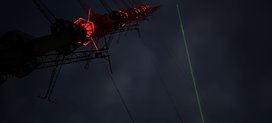
RS-lab activity within IPOS TNA of ATMO-ACCESS during the 3rd Intercomparison Campaign of UV-VIS DOAS Instruments (CINDI-3)
The 3rd Intercomparison Campaign of UV-VIS DOAS Instruments (CINDI-3) was held from May 21st to June 24th, 2024, at the Cabauw Experimental Site for Atmospheric Research (CESAR), operated by the Royal Netherlands Meteorological Institute (KNMI).
As a part of the ATMO-ACCESS TNA entiltled "Industrial Pollution Sensing with synergetic techniques (IPOS)" lead by prof. Iwona Stachlewska, the team members of RS-Lab (UW): Zuzanna Rykowska (co-PI), mgr Maciej Karasewicz, mgr Afwan Hafiz, and University of Silesia (UŚ): dr Anna Abramowicz, took part in the campaign to conduct measurements at the CESAR site. Additionally, the campaign was supported by a remote activity provided by mgr Emeka Ugboma (RS-Lab UW, PI of PANDORA_S2 spectrometer) and dr Kinga Wiśniewska from University of Wrocław (UWr, expert in modelling).
The primary objective of the CINDI-3 campaign was to intercompare UV-VIS trace gas remote-sensing instruments (e.g. DOAS instruments) to obtain reference measurements, which are crucial for the satellite data validation. The CESAR site is located between Rotterdam and Utrecht in a semi-rural environment. The stationary UV-VIS observations were complemented with a variety of instruments, a.o. atmospheric lidars.
The TNA IPOS team arrived on June 6th, 2024, with EMORAL (ESA Mobile Raman Lidar) and immediately started to measure. RS-Lab provided the Pandora_2S spectrometer, which normally serves as a part of the international Pandonia Global Network (PGN) at our Warsaw site. It was one of the most crucial instruments for the intercomparison during the whole campaign. Notably, it was also the only PANDORA with double spectrometers available for CINDE-3 observations! t is worth mentioning that the calibration of the Pandora 2Spectrometer is also crucial for the implementation of the "Synergetic aerosol remote sensing of Pandora within ACTRIS" AeroPAN project, funded by National Science Centre, Poland, in accordance with the Weave-UNISONO call of the Weave program (Project No. 2021/03/Y/ST10/00206). The lidar and spectrometer were also supported by the sun photometer (Microtops II) and the PC-3500 particle counter measurements done by Anna Abramowicz (UŚ).
The near-real-time data from the EMORAL lidar was evaluated using several software tools to convert and process the lidar data and obtain optical parameters of the atmosphere (e.g. developed by Afwan Hafiz tools: Emoral-DAQ and Emoral-EVAL). We also used the LiRaMi algorithm to classify the type of atmospheric aerosols developed by Dr Dongxiang Wang (RS-Lab UW).
Over 100 scientists from 16 different countries participated in the experiment while operating over 60 different instruments. The teams are now working on the results, which will be presented at the Advanced Earth and Space Sciences of AGU 2024 Conference, which will be held in Washington, DC, December 9th-13th, 2024.
Additionally, during the campaign, the EMORAL, which is the reference lidar for the data calibration and validation during the EarthCARE mission, was used by Maciej Karasewicz and Zuzanna Rykowska to measure under so-called dry-runs: simulated overpasses near Cabauw. Thus, important tests and practice were done before the future obligatory observations for the real EarthCARE satellite overpasses, which will happen soon in the framework of the POLIMOS activity!
After the EMORAL measurement in Cabauw, Afwan Hafiz and Maciej Karasewicz joined prof. Iwona Stachlewska in Landshut, Germany at the 31st International Laser Radar Conference (ILRC). During the conference, a life demonstration of the EMORAL lidar capabilities was presented to researchers from around the world! This was also a great opportunity to advertise the TNA: Trans-National Access to Research infrastructures still available within the ATMO-ACCESS project funded by EC in the frame of H2020 Programe.
Opublikowano dnia - 15 lipca 2024 12:03
Ostatnia zmiana - 20 września 2024 14:50
Publikujący - Sekretariat IGF
GALERIA ZDJĘĆ

